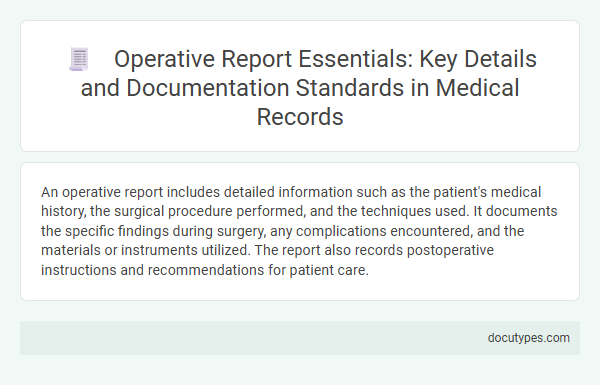An operative report includes detailed information such as the patient's medical history, the surgical procedure performed, and the techniques used. It documents the specific findings during surgery, any complications encountered, and the materials or instruments utilized. The report also records postoperative instructions and recommendations for patient care.
Introduction to Operative Reports
An operative report is a detailed medical document that records the specifics of a surgical procedure. It serves as a critical communication tool among healthcare providers and supports patient care continuity.
- Patient Information - Includes the patient's demographics, medical history, and preoperative diagnosis for accurate identification and context.
- Procedure Details - Describes the specific surgical technique used, instruments, and materials applied during the operation.
- Intraoperative Findings - Documents observations made during surgery, including any abnormalities, complications, or unexpected events.
The operative report ensures precise documentation essential for postoperative care, billing, and legal purposes.
Core Components of an Operative Report
An operative report includes essential details that provide a comprehensive account of the surgical procedure. Core components include patient information, preoperative diagnosis, and the exact surgical technique used during the operation.
The report also documents intraoperative findings, any complications encountered, and postoperative care instructions. Your healthcare team relies on this detailed record to ensure accurate treatment and continuity of care.
Preoperative Diagnosis Documentation
Preoperative diagnosis documentation in an operative report includes the patient's initial medical condition or symptoms prompting surgery. It details the clinical findings and diagnostic tests that established the need for the procedure. This information guides the surgical team's approach and helps ensure accurate treatment planning.
Detailed Description of Surgical Procedures
An operative report provides a detailed description of surgical procedures performed during an operation. It includes information on the incision type, surgical techniques used, organs or tissues involved, and any intraoperative findings. Your medical team relies on this report to understand the exact steps taken during surgery for accurate diagnosis and follow-up care.
Intraoperative Findings and Observations
What types of intraoperative findings and observations are typically included in an operative report? These details document the surgeon's real-time observations during the procedure, such as tissue appearance, unexpected anatomical variations, and the extent of disease. Your operative report ensures precise communication among medical professionals and supports postoperative care planning.
Postoperative Diagnosis and Outcomes
Operative reports include detailed postoperative diagnoses that clarify the patient's condition after surgery based on findings during the procedure. This information is crucial for planning further treatment and ensuring accurate medical records.
Outcomes in the report summarize the patient's immediate recovery status and any complications experienced during or after the operation. Your healthcare team relies on these details to monitor healing and make informed decisions about follow-up care.
Essential Patient Identification Information
| Detail Category | Description |
|---|---|
| Patient Full Name | Complete legal name as per identification records. |
| Medical Record Number | Unique identifier assigned to the patient's medical history. |
| Date of Birth | Exact birth date to confirm patient identity and age. |
| Gender | Recorded biological sex of the patient for accurate medical reference. |
| Contact Information | Phone number and address for follow-up and communication. |
| Admission Date and Time | When the patient was admitted for surgery, critical for timeline documentation. |
| Surgeon and Medical Team | Names and roles of the surgical team involved in the procedure. |
| Procedure Date | The date the operation was performed, essential for clinical records. |
| Preoperative Diagnosis | Medical condition identified prior to surgery indicating the need for the procedure. |
Accurate Reporting of Surgical Team Members
Operative reports contain comprehensive details about the surgical procedure, emphasizing the precise identification of all team members. Accurate reporting of surgical team members ensures accountability and enhances patient safety.
- Lead Surgeon Identification - The report specifies the name and role of the primary surgeon responsible for performing the operation.
- Assistant Surgeons - Names and specific contributions of assisting surgeons are documented to clarify responsibilities during the procedure.
- Supporting Staff - Anesthetic personnel, nurses, and other operating room staff involved in the surgery are listed to maintain a clear record of the entire surgical team.
Legal and Compliance Requirements
An operative report must include detailed information to meet legal and compliance requirements, ensuring accuracy and accountability in medical records. Proper documentation protects healthcare providers and supports patient safety through transparent communication.
- Patient Identification - Accurate patient details such as name, date of birth, and medical record number are essential to avoid misidentification and support legal compliance.
- Procedure Description - A clear, step-by-step account of the surgical procedure performed, including techniques and instruments used, provides evidence of standard care and legal documentation.
- Surgeon and Staff Information - Naming the primary surgeon, assistants, anesthesiologists, and nursing staff establishes accountability and fulfills regulatory documentation standards.
What Types of Details Are Included in an Operative Report? Infographic

